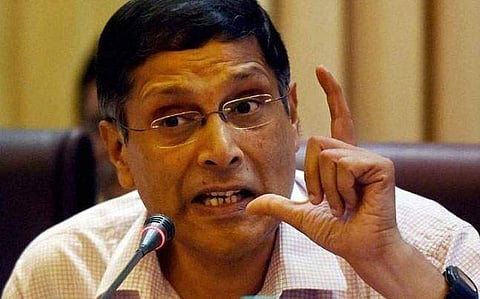

Former Chief Economic Adviser Arvind Subramanian made a startling discovery about India’s economic slump. Demonetisation first hotfooted the country’s growth, created a real estate ‘non-bubble bubble’, and in the end, it wildly careened the economy off the rails.
And, as we paced from a demo-led growth to a fall, Subramanian believes, the stubborn twin-balance sheet (TBS) problem morphed into a perplexing, four-balance sheet evil.
Just how did this happen? The money that flooded into banks after note ban encouraged unhealthy real estate companies to feast on debt. This was sponsored by non-banking financial companies (NBFCs), as banks that played fast and loose in the past were slammed shut of lending, but the excess liquidity found its way to realtors resulting in an inventory pile-up.
Builders placed their bets on India’s booming economy, rising middle-class, and Make in India, but none played by the script. Typically, when inventory rises, prices go up. But in this case, prices neither rose nor did they fall. Realtors were caught in a trap of their own, as underselling property would have reduced the collateral value, leading us into a ‘terrible doom loop’.
This phenomenon is what Subramanian calls as India’s real estate non-bubble bubble, which affected the financial system hard and caused the slowdown. Unsold inventory of over 10 lakh houses worth `8 lakh crore in 7-8 cities, in some ways, is akin to the US’ housing bubble. However, ours is a non-bubble bubble as the realty boom didn’t happen due to prices, but due to inventory build-up.
“If the TBS-1 was banks lending to infrastructure that went sour, TBS-2 is NBFCs lending to real estate that’s gone sour. Now, we have four balance sheets that are compromised. On the financial side, we have banks and NBFCs and on the real side, we have real estate and infra (excluding telecom and others)...and this is the unified explanation for the slowdown, bubble and the collapse,” Subramanian reasoned, while presenting a working paper co-authored with Josh Felman, ex-head, IMF India.
According to him, structural and cyclical slowdowns have a common link — the financial system. In our case, the TBS challenge, evolved into a four balance sheet challenge. “That’s why getting out of it is all the more difficult,” he emphasised. Though banks’ bad loans shrank, at `9.2 lakh crore they are by far the world’s highest.
NPA problem has not gone away: Former CEA
This excludes the new bout of bad loans that may pile up post-NBFC-real estate sector crisis.
That’s why, Subramanian believes, the NPA problem by no means has gone away. So, what’s the way out?
First among Subramanian’s five-point policy prescription is the need to make a clean breast of the underlying muck in NBFCs.
We need to know how big and how bad the stress is, as it eventually boomerangs on banks.
Like banks, the regulators should strengthen oversight on NBFCs, besides considering setting up a bad bank for real estate and particularly the power sector as their resolution depends on further policy actions.
“The slowdown definitely accelerated after the NBFC crisis. The financial sector has been weak and has been undergoing a clean-up. First banks, now NBFCs,” Dharmakirti Joshi, chief economist, Crisil, told this publication. The cost of this clean-up may well be slower growth.
“There is liquidity available for NBFCs. But, the cost is quite expensive, especially for weaker firms,” he further said. Joshi believes that this, in turn, will prolong the road to recovery.
“It is not the only issue, but it is certainly contributing. Which is why the path out of the slowdown is going to be very gradual,” he added.
Though IBC is one of the major achievements, giving an exit mechanism, it is a work-in-progress, and only Rs 83,000 crore recovered so far. Government has pumped a staggering Rs 3.5 lakh crore into banks, but Subramanian feels it should stop until it links recapitalisation to banking reforms.
Meanwhile, likening the current slowdown to the macroeconomic crisis in 1991, Subramanian said though we are nowhere near the 1991 crisis in the conventional sense, but if you look at the real economic indicators, we seem to be in that territory.
Dismissing the dominant view that lack of land and labour reforms accentuated the downturn, he said reforms can neither explain the cause for the slowdown nor the boom seen in the past.